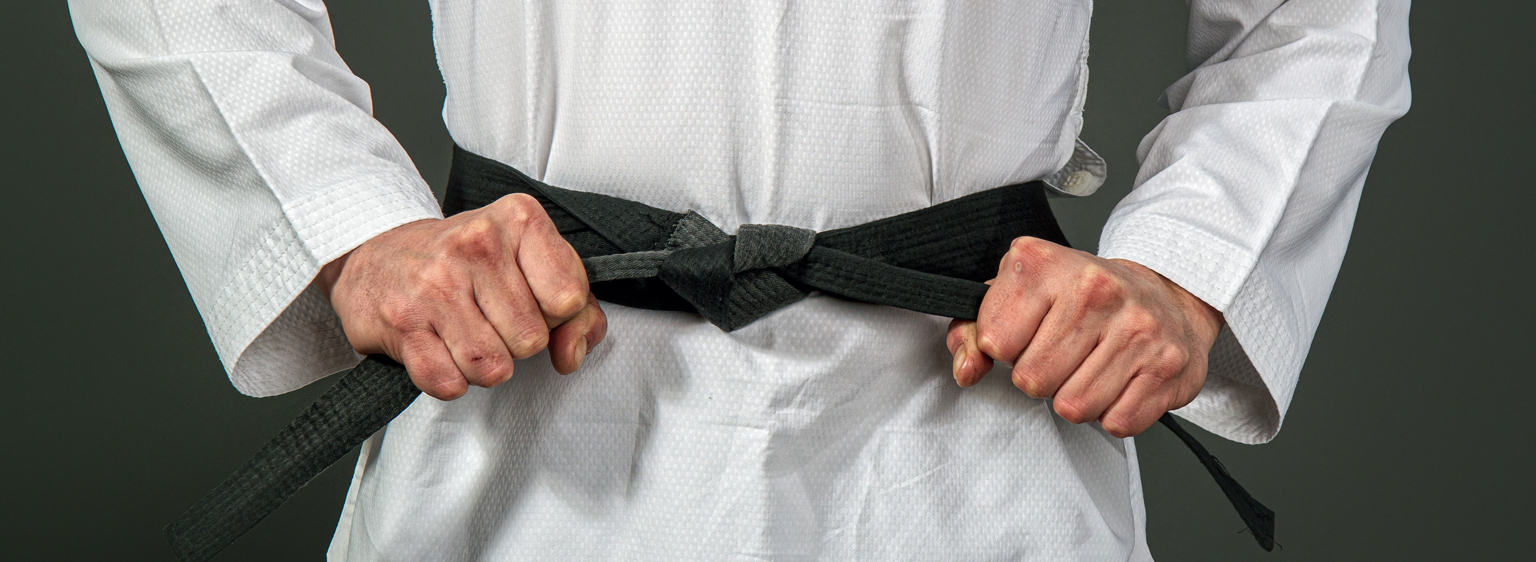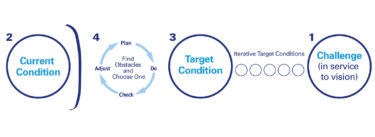Lean management is the polar opposite of the traditional approach, which is why traditional managers rarely understand why the necessary lean changes make any sense at all. Converting from traditionally run batch-and-queue type operations to lean flow-and-pull processes requires an entirely different way of thinking.
Traditional managers, for example, have been trained to believe that producing in large batches results in the lowest cost per item. They also think that organizing by functional departments is the most efficient approach. But, of course, organizing by function exacerbates the batching and forces companies to produce according to a forecast.
Then along comes a lean leader who says, “get rid of the functional departments, stop producing in big batches, and only build to the customers’ orders” — which makes no sense to a traditional manager. And even if they could grasp the theory behind lean thinking, they would have no idea how to make the operational changes required in finance and accounting, sales tactics and terms, product development, IT, strategic planning, and human resources. Yikes!
In my 40 years of implementing lean in various companies, I have never seen a company leader buy into lean and adopt its practices on their own using existing resources.
In my 40 years of implementing lean in various companies, I have never seen a company leader buy into lean and adopt its practices on their own using existing resources. They need help at first obtaining the knowledge of what lean is (the thinking and philosophy, if you will), and then with guidance and the hands-on experience of how to go about making the change. They need help answering questions such as: Where should you start? What obstacles can you expect? What is leadership’s role? What is even possible?
The lean sensei answers these questions and provides essential help by bringing the knowledge and experience to show how to transition from traditional management to lean management. Without this help, you cannot successfully transform to lean.
You have many options for obtaining the required lean knowledge. You can engage a lean consultant to bring it to your organization. You could also hire someone who has implemented lean in a couple of other companies to lead your lean conversion. Or you could train some of your existing employees by sending them to lean seminars and boot camps and having them form a Kaizen Promotion Office (KPO).
In my experience, the approach that works best is to hire a great lean consultant and plan to have their guidance for the next ten-plus years. The key is to pick the right one. There are many available candidates but few worthy ones. Avoid the large traditional consulting firms that focus on strategy and have a “lean team.” They will charge you a lot of money in return for many fancy PowerPoint presentations and the advice of bright young associates with little hands-on lean experience. Focus instead on finding a firm with direct experience in the Toyota Production System. Ensure that their bona fides include working for Toyota or being trained by ex-Toyota experts. Select only the teachers with hands-on experience helping companies convert to lean and achieve demonstrated financial and organizational benefits.
I say this from personal experience. As a group executive at The Danaher Corporation, I and one of my group presidents, George Koenigsaecker, decided to turn around Jacobs Vehicle Equipment (Jake Brake) using the Toyota Production System, known at the time as “just-in-time.” We started out using Arthur Andersen’s consulting arm. Lots of PowerPoint presentations, lots of young associates, and lots of money. It was slow going, but they did help some. Unfortunately, while they helped us create a couple of cells and made some progress, most of that came from aggressive behavior from George and me.
Then we came across the Shingijutsu consultants. They were from Nagoya, Japan, and had all had spent their careers at Toyota — the last ten years or so working directly with Taiichi Ohno, the father of the Toyota Production System. They spoke only Japanese and never gave us a PowerPoint or even a written report. Instead, they taught us how to organize and run a kaizen event and always guided people hands-on on the shop floor. Most importantly, they taught us how to see — and learn how to eliminate — waste. They were very rough and called themselves “Insultants.” But, boy, did we learn fast. We did whatever they told us to do even when we thought it was the stupidest thing we ever heard (which was about 50% of the time). And if their suggestion did not work the first time, which occurred most of the time, we would never let it go back to the way it was. We just stuck with the change and fixed it.
We learned — as you will too — that the consultants can’t always be with you. We had them for one week per month. We needed to do kaizen every day, so we created a Kaizen Promotion Office staffed with some of our brightest talent. To prepare, we had them stick to the Shingijutsu consultants while they were in town to learn from them. They spent the other three weeks of the month running and following up on kaizen work — an essential step that must be part of your plan. We had to train the KPO in-house, as there was no other lean expertise out there back in 1987. Today you have the luxury of being able to hire outside lean expertise to start your own KPO as well as train your in-house talent.
The KPO’s full-time job is kaizen and learning to become lean experts, which is a wonderful training ground for your future lean leaders: two years in the KPO then on to higher management roles.
Your lean sensei will provide expertise and push your people to remove waste.
Your lean sensei will provide expertise and push your people to remove waste. For example, Shingijutsu pushed us hard and showed us how to create one-piece-flow cells and standard work. They could merely look at something, say, “this is all no good,” and then quickly show us a much better way. Without their challenges, not much would have happened.
Take the simple example of setup reduction: If you need two to three hours to set up your equipment, you are forced to produce in batches, eliminating your ability to achieve flow. Unfortunately, most traditional managers take setup times for granted, saying, “Nothing we can do about that.” A lean sensei will stop you cold if you think that way. Prodded by these guides, I got involved in setup-reduction kaizen events that reduced:
- a rolling mill from 14 hours to 6 minutes
- a 750-ton injection molding machine from 5 hours to 5 minutes
- a 150-ton punch press from 3 hours and 10 minutes to 1 minute
- a cold header stamping press from 2 hours to 1 minute
- a complicated file folder assembly machine from 3 hours 45 minutes to 5 minutes
We achieved these improvements with only minimal capital spending. Machines we used to change three times per week at Wiremold, we started changing 20 to 30 times per day. Without the outside sensei, none of this would have happened.
When I was an operating partner in a private equity firm, I would serve as chairman of many of the companies we bought. One of the first things I did in each case was line up the company with a great outside lean consultant, either Shingijutsu or someone trained by them. Next, I would have the company create a Kaizen Promotion Office and staff it with some of their highest potential employees, so they could learn from the outside consultants. This approach allowed us to do new kaizen events every week while following up on prior ones. It built tremendous momentum in every company. Without introducing the lean expertise of the outside consultants, we would have made slow progress, if any at all.
But don’t forget management’s role in adopting lean thinking and practices. Yes, you need the outside help to bring the lean expertise and “lean eyes” to bear on the waste within your company. But management must eventually become lean experts themselves. When we first started working with Shingijutsu, George and I spent as much time with them as possible, asking questions and getting their insights. Not only were we with them on the shop floor, but we ate dinner with them every night and played golf with them on weekends so we could pump them for more information.
… my recommendation is that every senior staff member participates in six week-long kaizen teams each year and that the CEO, at least for the first year or two, be on 12 week-long kaizen teams per year.
But your real knowledge will come from being on kaizen teams yourself. So my recommendation is that every senior staff member participates in six week-long kaizen teams each year and that the CEO, at least for the first year or two, be on 12 week-long kaizen teams per year. I guarantee you will learn more about your company and your people doing this than you ever dreamed possible.
Get yourself a sensei and give it a try.
Virtual Lean Learning Experience (VLX)
A continuing education service offering the latest in lean leadership and management.






9/1995 General Electric Aviation- (AWO-5 Days Production Test) – S/U – Test – De-Prep S/U – Ship) AWO – Evendale, Ohio (2) Test Cell’s) (5 Days)
As my Master Lean Sensei – “Master Iwata San” – President of Shingijutsu (JP – World), would state… let us cut right to the elimination of all wastes. Let’s start in the production “TEST”; Cell’s “Schedule’s” / department(s) with the most waste, starting with Test S/U thru each process step to a finished product with a pull flow demand of TT; that will meet a Daily 24 hour, Variable TT of Scheduled Delivery, for your customer!
This sound simple to do: Right!
Iwata San, would say we can do this with simple flow charts at each work station, collecting all examples of (all waste in time, travel, corrections and scrap / unavailable parts / tools – tooling / manpower / material products) / (Timming Flow), Test Cell certification NA including the, (WHY?), for all the, “WASTE”… in (Test S/U (Completion)- (Test Engine to Qualification Schedule (Pass/Fail-Comp.) – (De-Prep to Ship / Return to Assy for Failure) – ( Repair- Re-Test (SHIP)!
This consisted of each Employee (that rotates (is trained) to all sub-jobs & leads in each Team Jobs in each department & his Team Leader & the Linkage of Top Leadership and one Production Manager from start to finish, and in each we will have One “Water Spider” & “One Maintenance Personnel to insure (3) Shifts of level loaded pull and maintenance support of three shifts (Variability) of Pull Demand Workflow components per Jet Engine Models are at the ready… Coupled with daily (@)(24) Hours of (3) Shift Production Demand of daily (24 Hr.) JIT, delivery of Customer demand!
After explaining this new learning “Lean Working Curve” to me he would ask, do we need any other added support to eliminate all the wastes (hidden and or the waste in plain sight)?
I, had to be very careful with my answer… “I would say, Master Iwata San… I believe, you have covered everything, completely!
He, would look at me for about 10-20 seconds and ask the same question, again?
I would respond with the same answer. He, then put his hand on my shoulder and said, Ron San, do you think that all the teams, people, leaders and managers, water spider and maintenance man have the “Same Waste Elimination -“Lean Groth Mindset” that we have?
That was an easy question for me to answer, I said.. “No Sir!”
He simply said, then you have a lot of prep work with, “EACH”… of the above, on a “TOTAL Waste Elimination Test Team AWO”… so they are all on the same “Lean Groth Mindset” of the Elimination of All the Waste in Progress from start to finish, … (Assy./Prep S/U, Test, De-Prep – Ship!) = “DILIVERY” (SHIP) (all within STD> Work Written Directions and New Engine Test Kitted Hardware, (Sequenced Work Level Loading with all Installations & Removal) – SU & De-Prep Engine Hardware Front / Back L&R Sides Top & Bottom of all said Jet Engine Models… “Kitted – PER. STD> WORK HR.”!
Waste Data Collection (Targeted and Highlighted) – Before 5 Day AWO
“Before” / Lean AWO 1-3 engines Test a day > (6) Engines would be a Max Targeted Completed in (3) Shifts Per day. (Assy. Bld. 700 deliveries to Test were operatic at best very, very – best) Some days no engines delivered to Test at All!
After / Investigations in Bld. 800 – Jet engine Assy Failures of Assy. & a Moving Assy. Line Moving Flow Line was Recommended! It was denied by the Union.
After, the (1 Week 5 Days Lean Test AWO), it was proven with 85-90% the Waste in Test removal and the Value-Added STD. Work and Kitting of all Test Hardware we could Test (6 Complete Engines) in One 24 Hr. Day – It was a massive improvement! Alas, the downfall was that Bld. 800 Union Assy Crews pushed back because they could not and would not install a moving ASSY. Line & Kitted Eng. Model Assy Line and do a Waste AWO Removal in their area like, we in Test… did ours! GEA Management in the long, term… sent all Commercial Jet Engine Test to a Remote Non-Union Test Site (Peebles – PTO) 75 Miles away. Long story short, Leadership would not work with the Union and the Union didn’t work with Leadership, GEA Outsourced from Evendale, OH over 300 Union & 400 Salaried People and eliminated all NEW Commercial Testing @ GEA Evendale, OH.
Ron San
Great article and perspective
My experience with companies that have achieved long term lean implementation certainly resonates
You need to engage the c suite over the long haul
Victor, I’m glad you enjoyed the post. Your right about engaging the C suite over the long haul. Too often companies start down the lean path with a good sensei, decide too quickly “ok we got this”, fire the sensei and before you know it are right back where they started.
This is all true, but, as you said, unless a VP like you commands it, it’s difficult to get division, plant or key support managers to do it. The norm in many big enterprises is to attend the kick off and the wrap up. Its window dressing, because there is pressure for them to say “great job’ in public, and they don’t really understand that change requires them to go right into the unknown and experiment. The plant walk tactics described in The Lean Sensei are a start. In The Sensei Way at Work, I describe one of my kaizen participants who got it when he said, “I’ve been waiting for you up front to give us the answer, but I just realized, no one knows it!”
Dan your right unless senior management, especially the CEO, understands that they need to become lean experts in order to lead a lean turnaround not much will happen. As lean is learn by doing attending a few kick off sessions to wave the flag so to speak won’t get you very far.
Well said Art
Regards
Sanjeev
Hi Art, very valid point – working with my Sensei completely changed the way I work… and Happy 40th Lean Anniversary to you!
Ovi, I’m glad you enjoyed the post and understand first hand the value of a good sensei. Your right I started my own lean journey in January of 1982 so this will be my 40th year. Makes me feel old but I’m still learning.
does Art have a directory of Lean Sensei consultants in Wisconsin?
Wil, unfortunately I can’t help you with that one but I’m sure there are some good ones as Wisconsin is a big manufacturing state.